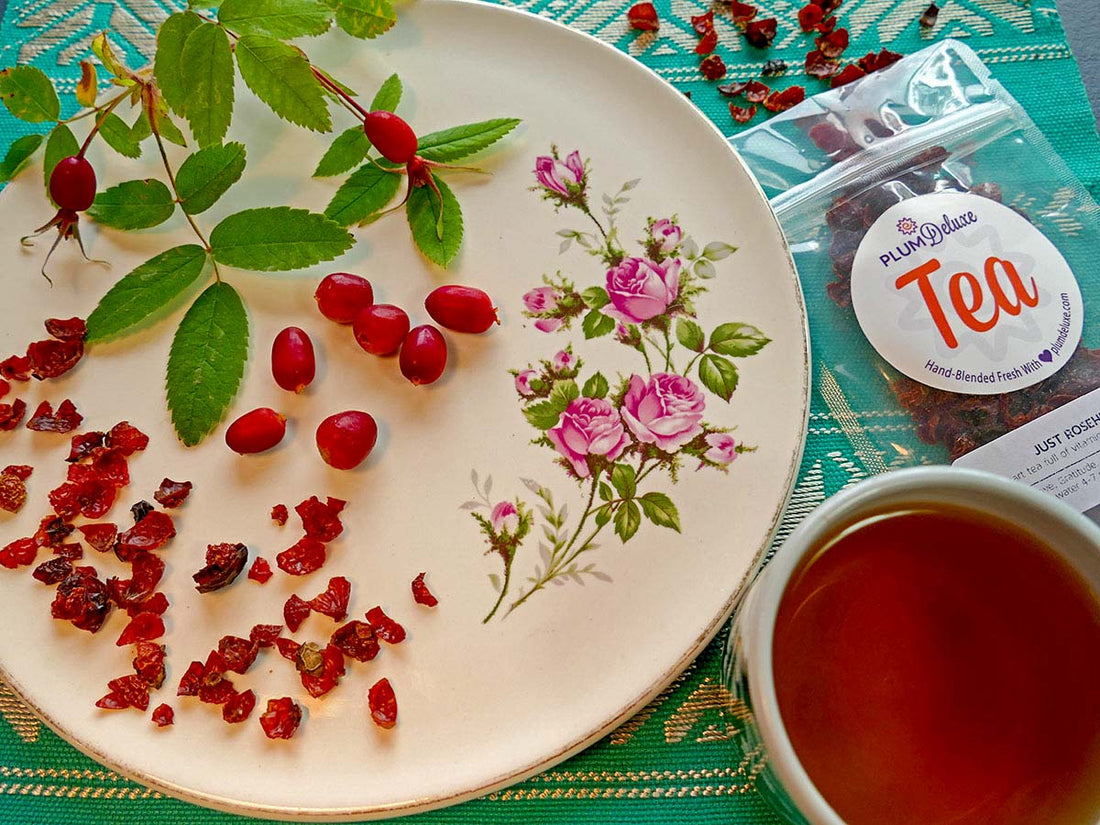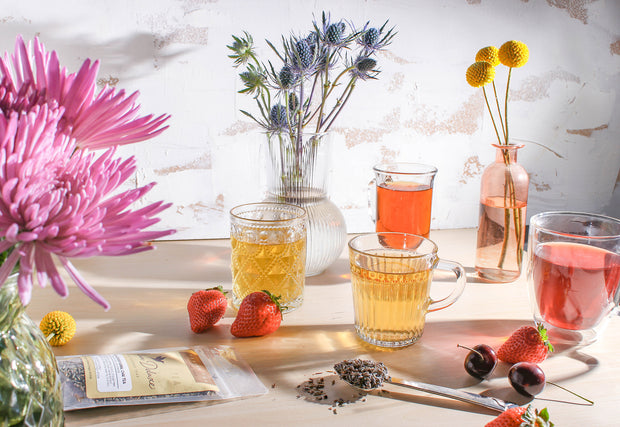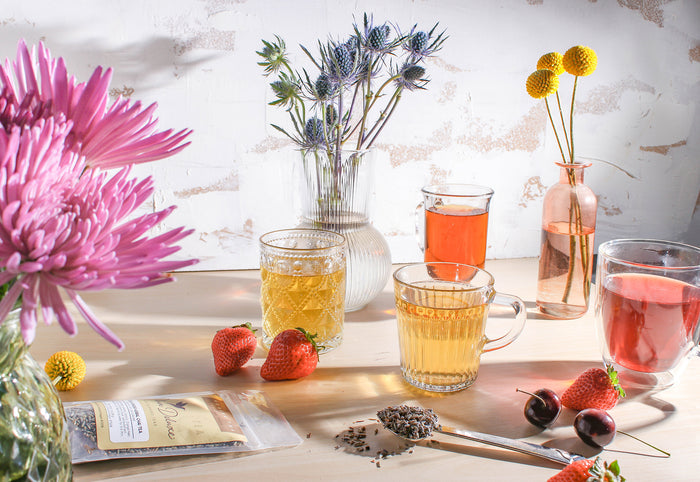Plum Deluxe recommends 4–7 minutes on the Just Rosehips package. I’ve let rosehips soak for hours when making syrup or jam. They don’t get bitter; they aren’t tea (Camellia sinensis).

So What are Rosehips?
Rosehips are the fruit of rose plants. They look like little red squids floating amongst the thorny branches. When you look at a lovely rose flower—especially one with a bee scuttling across its center, transferring pollen in exchange for nectar—you’re seeing a future rosehip. The flower petals will fall away and the hip will form.
Rosehips are green as they grow and usually turn red or orange as they mature; although, some turn purple. They ripen in autumn, and here in Alaska, there’s an ongoing argument about the best time to pick our wild prickly rose hips (Rosa acicularis): right before the first frost or right after. I say pick ‘em when they are fully red and still firm, and if you want a frost to sweeten them, put ‘em in the freezer for a few days. Waiting until they’re soft and nature-frozen makes them hard to work with and messy.

What do Rosehips Taste Like?
Don’t expect rosehips to taste like roses smell—or rosehip tea to taste like rose petal tea. Rosehips are a fruit unto themselves, with a flavor all their own.
With over 100 species of rose and thousands of ornamental varieties, it should come as no surprise that hips from different plants will have different flavors. Some can be tart, others fruity, and some are rumored to have a toffee or even chocolate flavor. Sign me up for those, please!
I find the rosehips from Plum Deluxe sweet, mild, and fruity, reminiscent of plum butter—and pumpkin. Okay, the plum makes sense: apples, peaches, pears, and plums are all in the rose family. But pumpkin? Yep. So it is. And I like to steep it extra-long to bring out that flavor.
Rosehips have a reputation for being tart, and there is a quick brightness that surrounds the deeper, fruity flavor, but I don’t find the dominant sensation to be tanginess, the way it is in lemon and hibiscus teas.

Preparation Tips for Rosehip Tea Blends
The subtleness of the rosehip flavor makes it ripe for blending.
Even though some find rosehip tea tart, it is commonly blended with other tangy flavors, like citrus, rhubarb, and hibiscus. Try rosehip tea with a squeeze of lemon or orange, or if you thaw frozen rhubarb when making pie, add some of the liquid to your rosehip tea. Temper the tang with honey, if you like. These make great iced teas.
A delicious example of blending rosehips with another tart flavor is Currant Conversation oolong tea, which adds the tartness of currants to the sweet-fruit-tanginess of rosehips and marries it to deep, warm vanilla-enhanced oolong, wrapping it in an invigorating brightness. This blend is more than the sum of its parts.
Mint is another recommended flavor to blend with rosehips. I confess it sounded like a strange combo to me, but I tried Just Rosehips with fresh spearmint leaves, and . . . surprise! . . . I loved it.
I’m partial, though, to chai (pumpkin!) spices: ginger, cinnamon, cardamom, cloves, nutmeg, allspice. This makes a wonderful warm tea, perfect for autumn and winter. Add a broken bit of a cinnamon stick and/or a couple of whole cloves and allspice, maybe some nutmeg gratings, to the infuser when you steep your rosehips. Or keep it simple and toss some rosehips into your favorite chai blend.
If sweet is your preference, add a touch of honey to your rosehip tea and rosehip tea blends. Or, better yet, maple syrup!

Rosehip Tea Pairings
If a flavor blends well with rosehip tea, it makes sense that foods with similar flavors would pair well with rosehip tea, right? So I strolled through the Plum Deluxe Recipe Index and came up with some fun recipes to try.
For a citrus pairing, how about Lemon Blueberry Tea Bread? Rosehip season is blueberry season here in Alaska—and that season is right now as I’m writing this! The lemon-blueberry combo is a delicious pick-me-up.
For a mint pairing, I’m going with Easy Peppermint Patties. Okay, this still strikes me as an odd combo, but the rosehip tea with fresh spearmint was delish, so I’m keeping an open mind.
And for a chai pairing, I choose Chewy Chai Tea Biscuits.

The Northern Tip for Rosehips
In northern communities—Alaska, Sweden, etc.—rosehips are traditionally dried for winter use because they are a good source of vitamin C and other nutrients that are hard to come by when the snow flies. In fact, there is more vitamin C in rosehips than in oranges, and the farther north a rose grows, the more vitamin C it contains.
Rosehip soup, an underrated Swedish dish, is a great way to get vitamins in winter. It’s faster and easier, though, to stock up on Just Rosehips in the fall, and toss them into your favorite winter teas.
“Which teas?” you ask.
As a tea adventurer, I would say “any tea you already love,” but let’s take a cue from Andy. Sweet Spot Butterscotch Black Tea contains rosehips. I think the sweet dessert teas are an excellent place to start, along with the previously mentioned chai.

A Final Rosehip Tip
This isn’t a preparation tip for rosehip tea; it’s more of a cleanup tip: After steeping your Plum Deluxe Just Rosehips, toss the soft hips in your smoothie or soup or salad. Consume every last nutrient in them, and—voila!—cleanup is a breeze.

![Spring Break Tea Variety Pack [6-Pack Variety of Flavors]](http://www.plumdeluxe.com/cdn/shop/files/spring-break-pack.jpg?v=1740682266&width=165)















